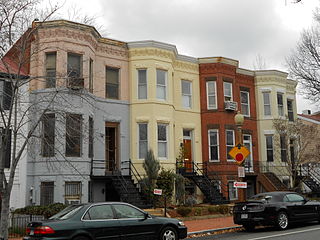
Capitol Hill, in addition to being a metonym for the United States Congress, is the largest historic residential neighborhood in Washington, D.C., stretching easterly in front of the United States Capitol along wide avenues. It is one of the oldest residential neighborhoods in Washington, D.C. and, with roughly 35,000 people in just under 2 square miles (5 km2), it is also one of the most densely populated.

Mount Pleasant is a neighborhood in the northwestern quadrant of Washington, D.C., the capital of the United States. The neighborhood is bounded by Rock Creek Park to the north and west; and Harvard Street, NW, and the Adams Morgan neighborhood to the south; and Sixteenth Street, NW, and the Columbia Heights neighborhood to the east. The neighborhood is home to about 10,000 people.

The Bates Building is a historic house in the Columbia-Tusculum neighborhood of Cincinnati, Ohio, United States. A two-story building constructed in a vernacular style of architecture, it is one of the oldest buildings on Eastern Avenue in the neighborhood.

Clauder's Pharmacy was a historic building in Cincinnati, Ohio. It was listed in the National Register of Historic Places on August 24, 1979. The address of the site is 4026 Eastern Avenue.

The Stephen Decker Rowhouse is a historic multiple residence in the Columbia-Tusculum neighborhood of Cincinnati, Ohio, United States. Built in 1889, it occupies land that was originally a portion of the wide vineyards of Nicholas Longworth. In 1869, after his death, Longworth's estate was platted and sold to builders who constructed a residential neighborhood along Tusculum Avenue. One of the most unusual buildings was the Decker rowhouse, which features multiple distinctive Victorian elements. Chief among these is the ornamentation on the porch roofs: they include gabled rooflines and beveled corners supported by multiple spindles. Connecting these porch roofs are low normal roofs, which primarily protect the recessed entrances to the houses. Elsewhere, the houses feature double-hung windows, imbricated shingles on the gables, and arcades of Gothic Revival panelling, and numerous ornamental circles inscribed within squares. Taken as a single building, the rowhouse measures two bays wide and eighteen bays long; it is of frame construction and two stories tall. Rated "outstanding" by an architectural survey in 1978, it is the only rowhouse of its type in Cincinnati, due to its well-preserved Victorian architecture.

The Hoodin Building was a historic apartment building in the Columbia-Tusculum neighborhood of Cincinnati, Ohio, United States. Built in 1881, it was once one of the neighborhood's most prestigious addresses. Despite its designation as a historic site, it is no longer standing.

The Kellogg House is a historic building in the Columbia-Tusculum neighborhood of Cincinnati, Ohio, United States. Built in 1835, it is a two-and-a-half-story building with two prominent chimneys on the ends. The weatherboarded walls rest on a stone foundation and are covered by a metal roof, which rises to a high gable on each end. The building's architecture is a mix of the Federal style with many vernacular elements; it has been recognized as one of the area's best examples of transitional architecture. Some of the distinctive features of the Kellogg Building are the small brackets that support the simple cornice, two wings attached to the rear, and the two enclosed porches on the facade. Inside, the main hallway is ornamented by such features as intricate fretwork and multiple pillars. Main hallway is also occupied by the homes original pipe organ.
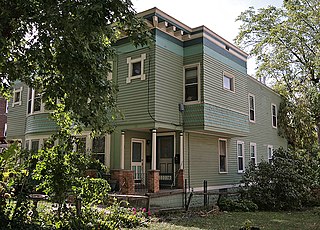
The Landt Building is a historic house in the Columbia-Tusculum neighborhood of Cincinnati, Ohio, United States. Constructed at the end of the nineteenth century, it has been named one of the neighborhood's numerous historic sites.

The LuNeack House is a historic residence in the Columbia-Tusculum neighborhood of Cincinnati, Ohio, United States. Built in 1894, it is a frame building with clapboard walls, two-and-a-half stories tall. The overall floor plan of the house is that of a rectangle, with the front and rear being the shorter sides, although the original shape has been modified by the extension of the rear and a hexagonal bay on the western side.

The Mardot Antique Shop was a historic commercial building in the Columbia-Tusculum neighborhood of Cincinnati, Ohio, United States. Built in 1889, it was a weatherboarded structure with a slate roof and built on a stone foundation. Three stories tall, the building was a simple rectangle, two bays by three, and it featured a simple symmetrical facade with a cast iron front and many windows. Other architectural features included multiple dormers in the roof, a small cornice with brackets, and a recessed portion of the storefront surrounding the main entrance.

The Norwell Residence is a historic house in the Columbia-Tusculum neighborhood of Cincinnati, Ohio, United States. A Victorian building constructed in 1890, it is a weatherboarded structure with a stone foundation and a shingled roof. The overall floor plan of the house is irregular: two and half stories tall, the house is shaped like the letter "L" but appears to be a rectangle, due to the presence of two separate porches that fill in the remaining area. Many ornate details characterize it, including imbricated shingles on the westward-facing gable end of the house, a frieze with spindles on the railing of the primary porch, and small yet cunningly crafted braces for the same porch. Yet more distinctive is the secondary porch, which sits atop the primary one; it features braces and spindles similar to those of the primary porch.

The L.B. Robb Drugstore was a historic pharmacy in the Columbia-Tusculum neighborhood of Cincinnati, Ohio, United States. Erected in 1860, it was a four-story building, constructed of brick on a stone foundation and topped with a slate roof. The building was a simple rectangle in its floor plan, although not without embellishments: the roof, which rose to gables on the sides, was crowned by a large central chimney, while the gables were ornamented with machicolations, and the walls were anchored by brick pilasters. After the drugstore was completed, it was modified by the addition of a wooden porch to one of the sides; aside from the porch, it measured four bays on the front, four on the rear, and four on each side. The windows were of plain lintel construction with lugsills on the sides.
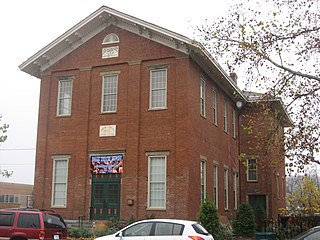
The Spencer Township Hall is a historic former government building in the Columbia-Tusculum neighborhood of Cincinnati, Ohio, United States. One of Cincinnati's oldest extant public buildings, it has been designated a historic site because of its architecture.

The Stites House is a historic residence in the Columbia-Tusculum neighborhood of Cincinnati, Ohio.
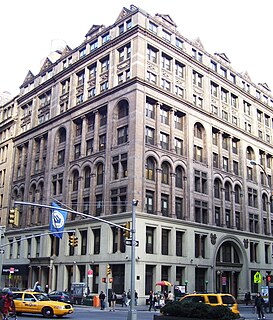
The United Charities Building, also known as United Charities Building Complex, at 105 East 22nd Street or 287 Park Avenue South, in the Gramercy Park neighborhood of Manhattan, New York City, near the border of the Flatiron District, was built in 1893 by John Stewart Kennedy, a wealthy banker, for the Charity Organization Society. It was designated a National Historic Landmark in 1991 for the role played by the Charity Organization Society played in promoting progressive social welfare policies, including the development of academic disciplines in that area.
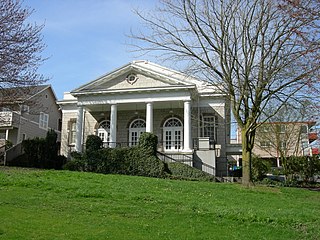
The Columbia City Historic District is a nationally recognized historic district located in the Columbia City neighborhood in the Rainier Valley area of Seattle, Washington. It is roughly bounded by South Hudson Street, South Alaska Street, 35th Avenue and Rainier Avenue. Its historic uses include specialty stores, multiple dwellings, single dwellings, meeting halls, schools, religious structures, and parks. Its architecture includes Mission Revival, Spanish Revival, Colonial Revival and other styles. On September 8, 1980, it was added to the National Register of Historic Places.
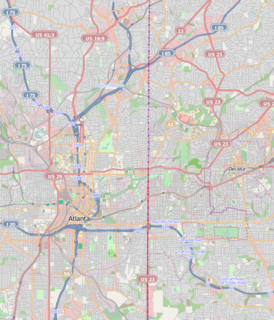
Winnona Park is a historic neighborhood in the southeast corner of the Atlanta, Georgia suburb of Decatur. It is listed as a historic district on the National Register of Historic Places, but it is not one of the City of Decatur's locally designated historic districts.

The Pioneer Memorial Cemetery is a historic pioneer cemetery in the Columbia-Tusculum neighborhood of Cincinnati, Ohio, United States. It is located on a small hill overlooking Lunken Airport at 333 Wilmer Avenue on Cincinnati's east side.
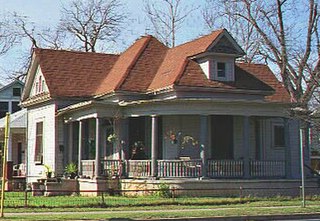
The Willow–Spence Streets Historic District is a neighborhood that lies east of downtown Austin, Texas. Its houses, churches, and commercial buildings were built in the early twentieth century. It is bounded roughly by Interstate 35 to the west, East César Chávez Street to the north, and Spence Street to the south. It extends a few houses east of San Marcos Street along Willow and Canterbury Streets. It thus includes portions of Willow, Spence, Canterbury, San Marcos, and Waller Streets. It was added to the National Register of Historic Places in 1985.





















